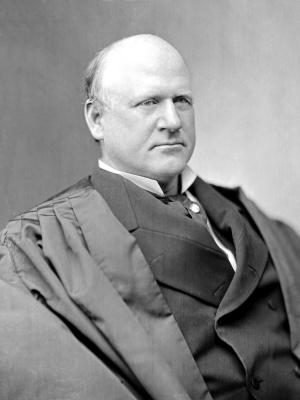
John Marshall Harlan served as an associate justice of the U.S. Supreme Court from 1877 to 1911. Harlan, a Kentuckian, had the nickname "The Great Dissenter" because he was the only justice to vote against the outcome of "Plessy v Ferguson" in 1896 and other cases that solidified the legal standing of segregation until the high court and Congress began to dissolve those laws in the 1950s and 1960s.
John Marshall Harlan served as an associate justice of the U.S. Supreme Court from 1877 to 1911.
A Kentuckian by birth, Harlan had the nickname "The Great Dissenter" because he was the only justice to vote against the outcome of "Plessy v Ferguson" in 1896 and other cases that solidified the legal standing of segregation until the high court and Congress began to dissolve those laws in the 1950s and 1960s.
Harlan was born at Harlan Station, 5 miles west of Danville, Kentucky in 1833 to a prominent slaveholding family, whose roots in the area date back to the American Revolutionary War. His father, James Harlan, was a lawyer and politician who served as a U.S. Congressman, Secretary of State, and state legislator.
He had several older brothers, possibly including a mulatto half-brother, Robert James Harlan, born in 1816 into slavery. His father raised his half-brother in his own household, making sure that he received an education. Historians have suggested that his closeness to his brother may have influenced Harlan to argue on behalf of equal rights.
After attending school in Frankford, Kentucky, Harlan graduated with honors from Centre College in Danville. Although his mother wanted him to become a merchant, his father encouraged him to follow him into the legal profession, and Harlan joined his father's law practice in 1852. While his father could have trained his son in the office, as was the norm of "reading the law" in that era, he sent the younger Harlan to attend law school at Transylvania University in 1850. He finished his legal education in his father's law office and was admitted to the Kentucky Bar in 1853.
He entered state politics in 1851 eventually serving as Attorney General of Kentucky from 1863-1867.
Throughout his political career, Harlan was quite versatile in his political affiliations. He was first aligned with the Whig party like his father until it dissolved in the early 1850s. He shifted his affiliation to the Know Nothings, despite his discomfort with their opposition to Catholicism. He renounced his allegiance to them to support the Constitutional Union party backing John Bell in his run for president in 1860 against Abraham Lincoln. He next joined the National Union party, and then the Democratic party to campaign for George McClellan in the 1864 presidential election against Abraham Lincoln. In the 1876 presidential election, Harlan worked to nominate Bristow as the Republican party's nominee, though when Rutherford B. Hayes emerged as the compromise, he switched his delegation's votes and subsequently campaigned on Hayes' behalf.
Originally a Union supporter, after the election of Ulysses S. Grant as President in 1868, Harlan reversed his allegiance and became a strong supporter of civil rights.
He was appointed as a member of the Supreme Court in 1877. He was 44 years old when he ascended to the High Court and cut quite an impressive figure. At six feet, two inches tall and something over 200 pounds with thinning reddish blond hair and an erect bearing, he conveyed an impression of robustness that stayed with him for the nearly 34 years he served on the Court.
A Christian fundamentalist, his beliefs strongly shaped his views during his tenure. He is best known for condemning racial segregation in his lone dissenting of Plessy v. Ferguson in 1896, when he declared, "Our Constitution is color-blind." He expressed the fear that the majority decision would relegate African Americans to a permanent "condition of legal inferiority." Only in 1954, with its decision in Brown v. Board of Education, did the Court finally repudiate the "separate but equal" principle established in Plessy.
Harlan believed that the judiciary should serve as the defender of private property and the rights of individuals. His tenure of 33 years on the Court was one of the longest in history, and he wrote a total of 1,161 opinions, of which 316 were dissents.
He married Malvina (Mallie)French Shanklin in 1856, the daughter of an Indiana businessman. The pair had six children, three sons, and three daughters. A grandchild, John Marshall Harlan II, went on to serve as a Supreme Court Associate Justice from 1955 to 1971.
Sources: American National Biography Online, Wikipedia, Biography.com, PBS Biographies of the Robes
